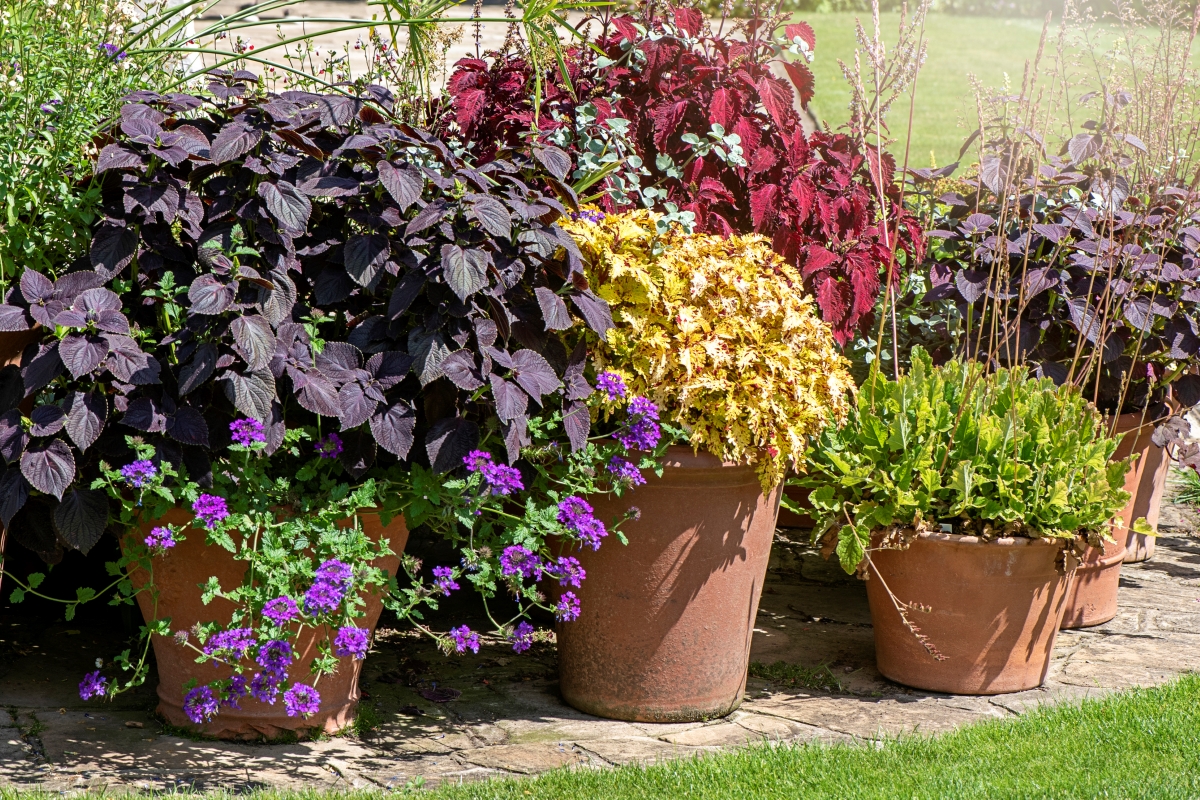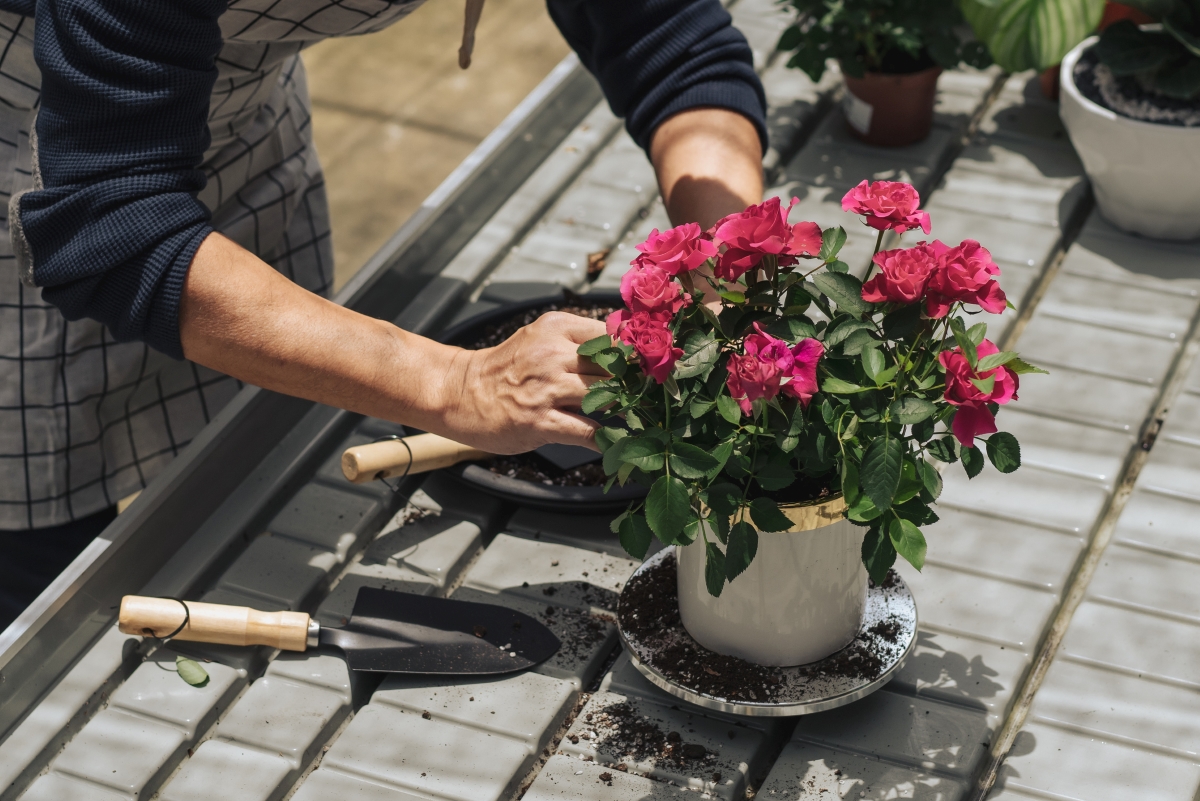

We may earn revenue from the products available on this page and participate in affiliate programs. Learn More ›
Can you plant perennials in pots rather than in the ground? Yes, and there are many benefits to adding perennials to your container gardens. As the University of Georgia Extension notes, they can “offer permanence to mixed containers that may appeal to those who want the long-term beauty associated with mixed container plantings without the work associated with seasonally changing out plant material.”
Many gardeners don’t like the fuss of having to refill containers every spring with plants—annuals—they know are going to die come fall. Fortunately, many perennials, with the right care, are well-suited to containers
Benefits of Growing Perennials in Containers
When considering annuals vs. perennials for your potted garden, keep in mind that you actually can combine the 1-year plants with the longer-lived ones if you prefer. You will need to take steps to protect outdoor plants in pots during the winter, but growing perennials in containers will allow you to do the following:
- Avoid repurchasing new flowers for pots outdoors every spring. Instead of buying and planting new annuals to fill up your containers every year, watch your perennials spring to life as temperatures rise.
- Move potted perennials as often as necessary. Should you have container plants for shade, which need some sun to bloom well but resent hot temperatures, you can place their pot in a sunny location during the cooler months and easily move it into the shade after the weather heats up.
- Grow perennials that you wouldn’t be able to grow otherwise. Where certain types of soil don’t allow you to raise, for example, hardy cacti and succulents in the ground, place those plants in containers filled with cacti potting mix instead.
- Repurpose your plants for containers if necessary. If they grow too large for their pots, you can simply transplant them to your flower beds in the spring, or in some cases, divide them at the roots for use in multiple pots..
How to Plant Perennials in Pots

Once you have chosen your perennial flowers for potting, planting and caring for them is about the same as caring for annuals.
Containers
If you intend to leave your potted perennials outdoors without protection during the winter, and you live in a place that gets frequent freezes, carefully consider the types of pots you put perennials in. Wood, concrete, metal, or fiberglass containers make the best planters for cold conditions, since terra-cotta and pottery types are likely to crack under the pressure of frozen soil expanding inside them. Also, opt for large pots, at least 18 inches in diameter for three perennial plants, for example. You want to provide at least 3 inches of space for extra soil beneath the root balls of those plants.
When coming up with container perennial garden ideas, consider using your “pots” to create a unifying theme. For example, antique metal containers salvaged from a junk pile would work for a rustic garden, classical urns for a more formal one.
Soil
Use a bagged potting mix that is appropriate to what you are planting: a standard mix for most plants, cacti mix for cacti and succulents, or an acidic mix for acid-loving plants. Since water retention is almost always a concern in containers, you may want to add one part compost for every three parts of the mix to keep your plants hydrated longer. Moisten the potting soil while it still is in the bag before you add it to your container.
As Rutgers University warns, “Soil from the garden is never recommended. It is too dense, compacts easily and will not allow proper drainage and aeration. It may also introduce unwanted elements, such as fungi, soil-borne insects, and weed seeds, to your container.”
Plants
If you don’t plan to provide any winter protection for your potted perennial flowers—or potted perennial herbs or perennial vegetables, for that matter—you will need to choose particularly hardy ones. As the Minnesota State Horticultural Society notes, “The general rule is that for a perennial to survive in a container outside it should be hardy two zones colder than your zone.”
When picking perennials for pots, aim for a mix of thrillers, fillers, and spillers. A thriller is a large, showy plant that occupies the back or middle of the container. A filler is a more rounded type that fills the space in front of or around that thriller, while a spiller cascades over the side of the container. Make sure all plants in the container prefer the light exposure, as full sun plants for pots won’t coexist well with shade lovers.
Maintaining a Perennial Container Garden
If you leave your perennials in their original nursery pots when placing them in a larger container, you can easily swap out your spring flowering perennials for those that flower in summer, and then you can swap the summer bloomers for fall color at the appropriate times. This strategy doesn’t guarantee the healthiest plants, however, as rootbound plants might be unable to get adequate hydration and nutrients. In general, plants in containers dry out rapidly during the heat of summer and might need to be watered as frequently as twice per day during that time.
Similarly, plants in containers can rapidly deplete nutrients, and so consider watering them with a balanced water soluble plant food—such as a fish and seaweed emulsion— once every week or two. Depending on where you live, you might want to stop fertilizing your perennial plants for pots after the beginning of August since you will want them to harden off before winter.
Keep in mind that whether they’re in the ground or in containers, many flowering perennials benefit from deadheading, so take the time to pinch off any faded flowers from the plants to keep them blooming as long as possible.
How to Overwinter Potted Perennials

If you live in an area that experiences frequent or prolonged winter freezes, you’ll want to take steps in late autumn to protect any container perennials that aren’t extremely hardy when they are beginning to die back but before the ground freezes.
Put Them in the Ground
One way to protect your container perennials during the winter is to give them the protection in-ground plants have. You can do that by digging holes as deep as the containers. Set each pot in its own hole, backfilling the soil around it, and adding a little mulch over the surface of the pot’s soil. The plants now will look as if they were planted in the ground and should be as protected as if they were. You’ll want to save the excavated soil so you can backfill the holes in the spring once you remove the pots from them.
Move Them Into a Structure
Another option is to move the containers into an outbuilding or other protective structure such as a shed, garage, or cold frame. Some perennials can come into the house, some need a chilly dormant period in order to thrive, and others can even take brief periods of freezing weather.
Check your dormant plants about once every 2 weeks to make sure that their soil isn’t drying out.
Put Them in a Protected Location
If you can’t bury your plants or move them under a roof, find a place protected from wind—such as on the east side of your house—to group them. Then place them inside a mini hoop house topped with white plastic or cover them with some type of mulch.
For example, you can surround the pots with straw bales and then dump dead leaves inside that enclosure deep enough to cover the pots and fill in the spaces between them and the bales. Make sure the plants’ soil is damp when you cover them and check them occasionally throughout the winter to make sure that soil stays damp but not soggy.
Know your plants and overwinter them accordingly.
